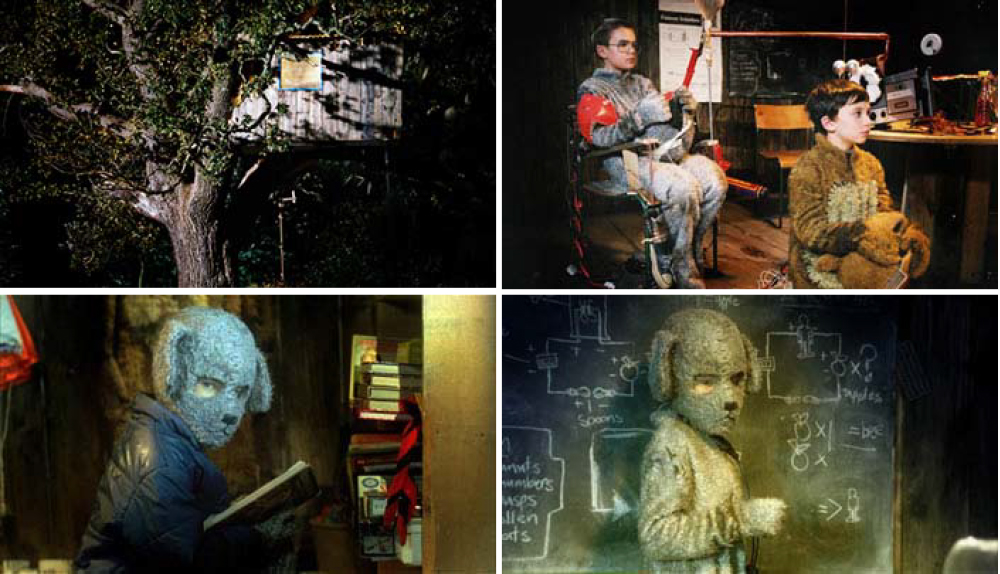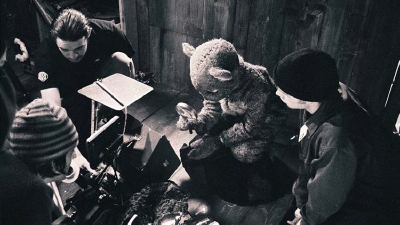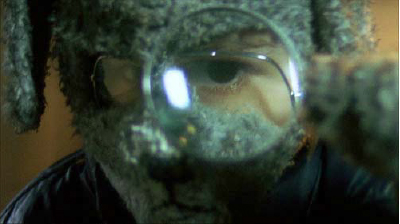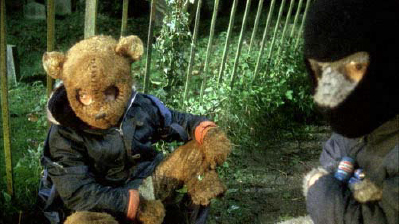HIBERNATION SPRINGS TO LIFE WITH THE ADOBE VIDEO COLLECTION AND BLUEFISH444 HD|FURY
01 September, 2006
John Williams, one of Britain's up and coming film directors, used the Adobe Video Collection and Bluefish444's HD|Fury to produce Hibernation, a fifteen-minute live action/animation short for the big screen.
CUSTOMER OVERVIEW
As a young filmmaker John Williams has already received numerous accolades. His animated short Robots won the Mclaren Award at the Edinburgh International Film Festival 2000, he has won 'Best Young Director', as a co-director, at the Cannes Advertising Awards for Greenpeace (co-directed by David Lea) and he has directed videos for Offspring, Coldplay, as well as having a role in producing the visual effects for Radiohead's 'There There' promo.
John Williams picked up six prestigious awards for Hibernation at international film festivals, including 'best short' award at the 2005 Manhattan, Rhode Island, Edinburgh and Zagreb Film festivals.

TAKING AN ANIMATION SHORT TO THE BIG SCREEN
Hibernation is a fifteen-minute live action/animation short for the big screen. It is a magical and moving story about two children on a journey of discovery and revelation. Set in 1985 in a secret tree house, the film portrays the two children disguised in animal costumes carrying out experiments in the hope of reviving a bee. Ultimately they are searching for a way to bring back something much bigger.
 The original idea for Hibernation came from a variety of influences. When Williams finished the animated documentary, Robots in 2000, he was considering the ideas around telling stories of characters and their emotional struggles, but in disguise.
The original idea for Hibernation came from a variety of influences. When Williams finished the animated documentary, Robots in 2000, he was considering the ideas around telling stories of characters and their emotional struggles, but in disguise.
Attracted to strange worlds and characters that can be created in animation, Williams feels that a fairy tale allows more room for creative freedom. For many, fairy tales were an important part of childhood and even today's contemporary stories for children draw on the timeless fascination of these linguistic roots. The contrasts of light and dark concepts within fairy stories make them simple to follow and universally understandable, the imagery and surrealism within firing the imagination.
Behind the project were a number of renowned sponsors: Working Title 2, Arri Media and Kodak. Peter Lowe of Screen Channel was the executive producer and the film was shot at Pinewood Studios as well as on location.
Through the production company, Sound Films, Williams was given the resources to shoot on Super 16 film and had a crew of over thirty people supporting the production. Having used Adobe technology for many years the Adobe Video Collection was the natural technology choice for producing Hibernation.
SOLUTION
Adobe Video Collection and Bluefish444 HD|Fury: providing flexibility and releasing creativity
As the professional standard in desktop digital imaging, Adobe Photoshop CS1 was used on the project to create and develop the mood and feel of the film. By providing efficient editing, processing, and file handling, stills could be taken from the film early on in the project and a template created to lobby potential sponsors as the project kicked off and to promote Hibernation as the film developed.
One of the key requirements for Hibernation was to use technology that allowed the recording and editing of video assist footage from the film camera on set. Adobe Premiere Pro 1.5 allowed the team to do just that. The Adobe software revolutionizes nonlinear video editing, giving precise control over video and audio production. It allows filmmakers, like Williams, to see exactly how the film will look with every edit, and full-resolution results can then be played back in real time on NTSC, PAL, or VGA monitors.
The team used 'video assist' to record directly to Adobe Premiere Pro whilst filming on set. By employing an analogue to digital converter, they were then able to digitize footage immediately and capture every bit of the film onto computer. The benefits of doing this were numerous. Editing takes from Hibernation to see how a scene was progressing allowed John to determine if any additional shots for the film were needed while on set. He was able to deal with problems that were not foreseen in advance.
Source material for Hibernation was shot on Super 16mm film. The video assist was recorded by taking a composite feed from the film camera, and this composite feed was then converted to DV, which was recorded onto a laptop. This footage was then used to check shots on the set.
The Super 16 film was then telecined to HD D5 tape at leading post-production facility Rushes in its "Spirit" grading suite to an overall tone that provided John with greater flexibility.
DV rush transfers of the footage were then used to produce a base edit, which was then re-conformed from the HD D5 tapes. Due to time constraints, this re-conform was done partly at HD resolution and partly at SD resolution. The re-conformed footage was captured into the Bluefish444 V210 uncompressed format using a Bluefish444 HD|Fury card. SD was chosen after initial work at HD resolution was found to be too time consuming. Rendering SD compositions took a fraction of the time of HD, since a HD image is approx five times the size of an SD image.
 "Adobe and Bluefish444 technology played a large part in ensuring continuity and positioning in takes. We were able to consider such elements of the editing process while filming Hibernation. The result? A greater element of continuity in Hibernation" said John Williams, Director.
"Adobe and Bluefish444 technology played a large part in ensuring continuity and positioning in takes. We were able to consider such elements of the editing process while filming Hibernation. The result? A greater element of continuity in Hibernation" said John Williams, Director.
Adobe Premiere Pro and the Bluefish444 HD|Fury allowed Williams and his team to exploit standard desktop workstations providing the team with greater flexibility in terms of the work environment. They were able to move between PC and laptop and could switch workstations to render nodes so the overall process was much faster.
Since the Bluefish444 V210 uncompressed codec could be installed on several machines independently of the hardware, the increase in productivity and flexibility added enormously to the project. The V210 codec is cross platform between Mac and Windows, which meant that Bluefish444's PC products could also be integrated into a Mac workflow.
Williams has always found that even if, at the start of a project, little effects work is intended, the reality and restrictions of making films that embrace innovative ideas mean that it is not possible to achieve everything by camera alone. However, as the essential tool for motion graphics and visual effects, Adobe After Effects 6.5, gave Williams the speed, precision, and power to be visually innovative, deliver quality results, and meet production challenges.
Adobe After Effects enabled Williams' imagination to become a reality. Visual continuity, visual effects, animation and final grade were all done in Adobe After Effects. Visual continuity required elements to be inserted after filming extremely precisely in some scenes such as lights in a tree near a shop and a bee buzzing in a jar. Visual effects included electricity and sparks on a homemade electrical generator and animations were composited onto a dirty window. Adobe supported Williams and his team with the post-production and an Adobe consultant helped to handle some of the effects shots.
The Bluefish444 HD|Fury was used for all the final editing and compositing, exploiting the SD preview of the down converted output to view material on a standard production monitor for grading in After Effects.
The preview enabled Williams to see how the process was going on a monitor at all times, eliminating any guesswork. A TFT was also calibrated to be as close to the broadcast monitor as possible, allowing others to work in After Effects and exploiting the Bluefish444 V210 codec to its fullest potential. This resulted in significant time savings and efficiency, since work could be done away from the main editing workstations when they were busy rendering.
"I really like the control you have in post production and animation, especially if you can work and experiment hands-on," Williams says of Adobe After Effects and Bluefish444. "For example, the grade control in Adobe After Effects allowed me to re-light scenes, add additional camera moves and add layers of smoke and dust to enhance the musty atmosphere of the wooden hut."
INNOVATION AND CREATIVITY REALIZED THROUGH TECHNOLOGY
 The compatibility and integration afforded by using the Adobe Video Collection products meant that shots could be easily manipulated to determine how they would appear in the final edit. Being able to cut and paste between the various tools, Adobe Photoshop, Adobe Premiere Pro and Adobe After Effects provided enormous benefit in terms of continuity and time efficiency. Editing the film using Adobe Premier Pro and then passing it to Adobe After Effects for colour correction, effects and titling provided a seamless workflow. By using Adobe Premiere Pro and Adobe After Effects, it was possible to render stop motion effects in one of the shots for Hibernation while on location, thereby ensuring there and then that the experimental technique being used would actually create the effect required.
The compatibility and integration afforded by using the Adobe Video Collection products meant that shots could be easily manipulated to determine how they would appear in the final edit. Being able to cut and paste between the various tools, Adobe Photoshop, Adobe Premiere Pro and Adobe After Effects provided enormous benefit in terms of continuity and time efficiency. Editing the film using Adobe Premier Pro and then passing it to Adobe After Effects for colour correction, effects and titling provided a seamless workflow. By using Adobe Premiere Pro and Adobe After Effects, it was possible to render stop motion effects in one of the shots for Hibernation while on location, thereby ensuring there and then that the experimental technique being used would actually create the effect required.
The Bluefish444 range of products are tightly integrated with Adobe After Effects, Premiere Pro and Photoshop, offering filmmakers such as Williams strong continuity and simplicity of use.
"The Adobe and Bluefish444 applications are designed to work together and so the process was simple. The final grade was done on After Effects at 1920X1080 High Definition resolution over a few days in my bedroom and it was quite a break-through to discover we could do such a full-on grade for 35mm film print all on a high powered home PC," said Williams.
THE BIRTH OF HIBERNATION
A week after the shoot a rough assembly of Hibernation was finalized by Editor Jamie Pearson, who’s past credits include the 2004 feature film King Arthur. Pearson cut the film, shot on Super 16 and then did an assembly edit from a Digital Video layoff using Adobe Premiere Pro and the edit suite facility, Run VT. Leading post-production facility Rushes, then agreed to grade the film in telecine and at high definition so that it was suitable for television and the big screen.
Using Adobe Premiere Pro they then produced a rough cut of the whole film. The Adobe consultant took on the role of post-production supervisor on the film and worked with the Adobe Video Collection, the Bluefish444 codec, and a plug-in, Anarchy Toolbox from Digital Anarchy, to collaborate with the film house and Mollinaire film transfer department to enlarge images to provide a higher definition end result. This enabled the team to mix and match standard and high definition material and rather than digitizing all material, they were able to select only the material which they wanted to turn into high-definition elements. The cost benefit of this was significant. It required less disk space than originally anticipated and most importantly it meant that the team could work at film resolution levels during the editing process, giving Williams the chance to play with and manipulate certain images. Williams could create his magic whilst keeping to a film resolution quality.
"I have a very hands-on approach at the post-production stage," Williams commented. "Coming from a visual and artistic background, I find it easier to express ideas visually, so when working at the post-production level, I like to work closely with the images. Using Adobe's technology allowed me to do just that."
He continued, "The flexibility of Adobe software with the Bluefish software codec meant I and others could work on shots from the film whilst not on the main editing machine."
"Without Adobe and Bluefish444, I don't think the film would have been made, to be honest. It sort of - you know - technically, especially in post-production, there was so much we needed to do, and, especially to give us the creative ability to do things ourselves," stated Andy Gordon, Producer, Hibernation.
SUMMING UP
The Adobe Video Collection and Bluefish444 HD|Fury enabled Williams to fully realize his idea of a live action/animation short for the big screen. Having control over the filming and editing process allowed him to bring to life the characters and story of Hibernation. Using Adobe Premiere Pro to record and edit footage on set, as the film progressed, provided greater continuity in the final film and dramatically reduced the time and cost involved. The flexibility and cost benefits of using standard desktop workstations was also significant.
Using Adobe After Effects gave John the creative control he needed to enable his imagination to become a reality. The restrictions of working with film meant that it was not always possible to achieve all of his innovative ideas on camera but Adobe After Effects solved this problem.
The workflow benefits of the Adobe applications significantly reduced the time and cost that would have been incurred if John and his team had had to move between different tools and formats rather than seamlessly moving between Adobe Photoshop, Adobe Premiere Pro and Adobe After Effects.
COMPANY NAME - John Williams and Sound Films
TOOLKIT LIST PRODUCTS USED
Adobe Video Collection: Adobe Premiere Pro 1.5, Adobe After Effects 6.5, Adobe Photoshop CS1
Bluefish444 HD|Fury
CHALLENGES:
Production of an innovative fifteen-minute live action/animation short for the big screen with considerable budget and time constraints.
SOLUTION:
Adobe Video Collection and Bluefish444 HD|Fury
BENEFITS:
Flexibility and continuity of work environment
Realization of filmmaker's innovative and creative ideas
Time efficiency
Cost savings
### Adobe, the Adobe logo, and Tools for the New Work are either registered trademarks or trademarks of Adobe Systems Incorporated in the United States and/or other countries. All other trademarks are the property of their respective owners.


